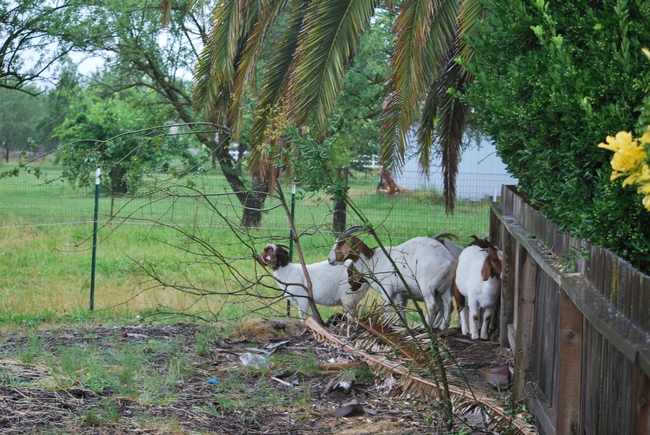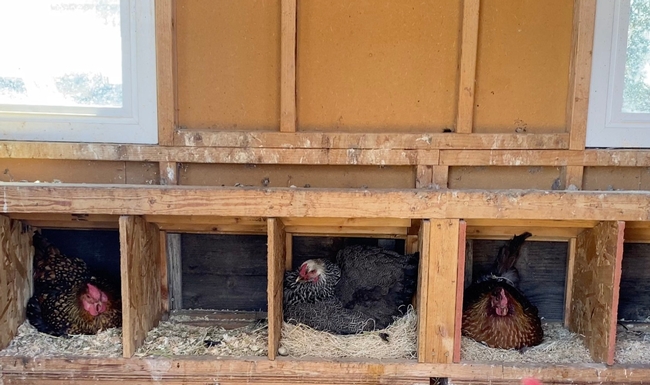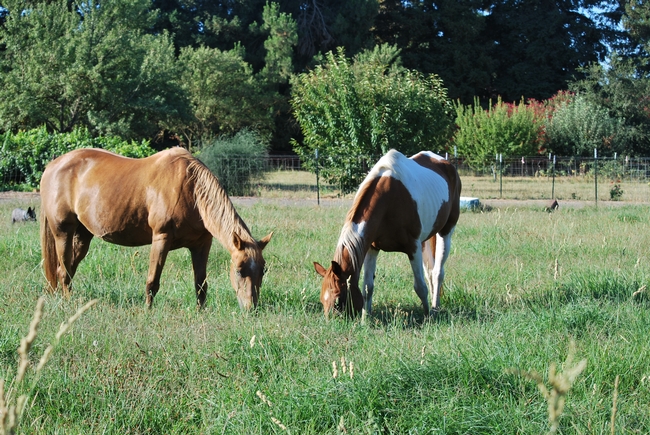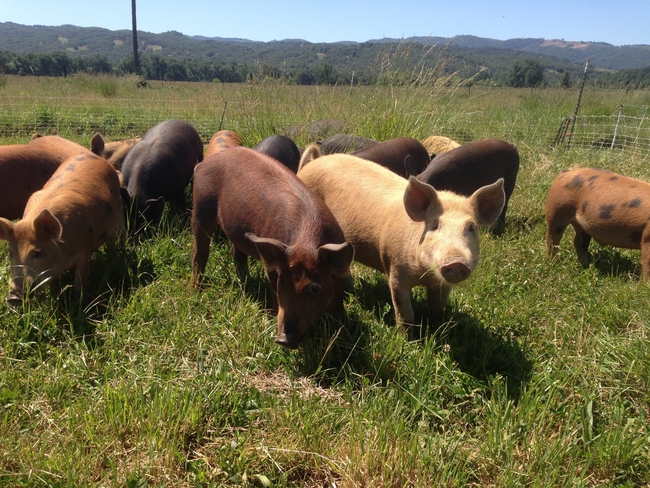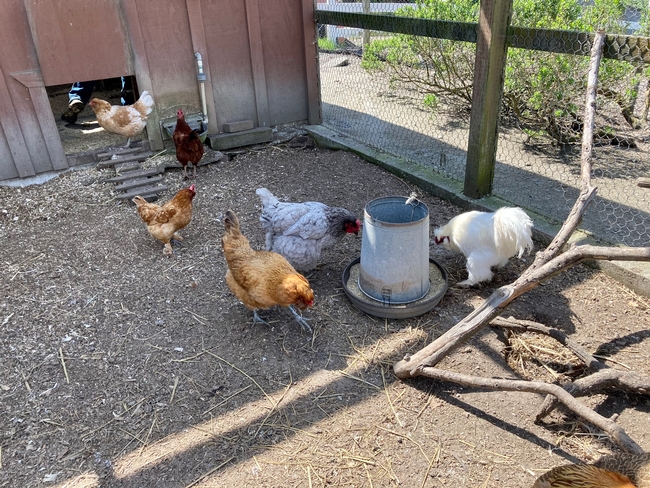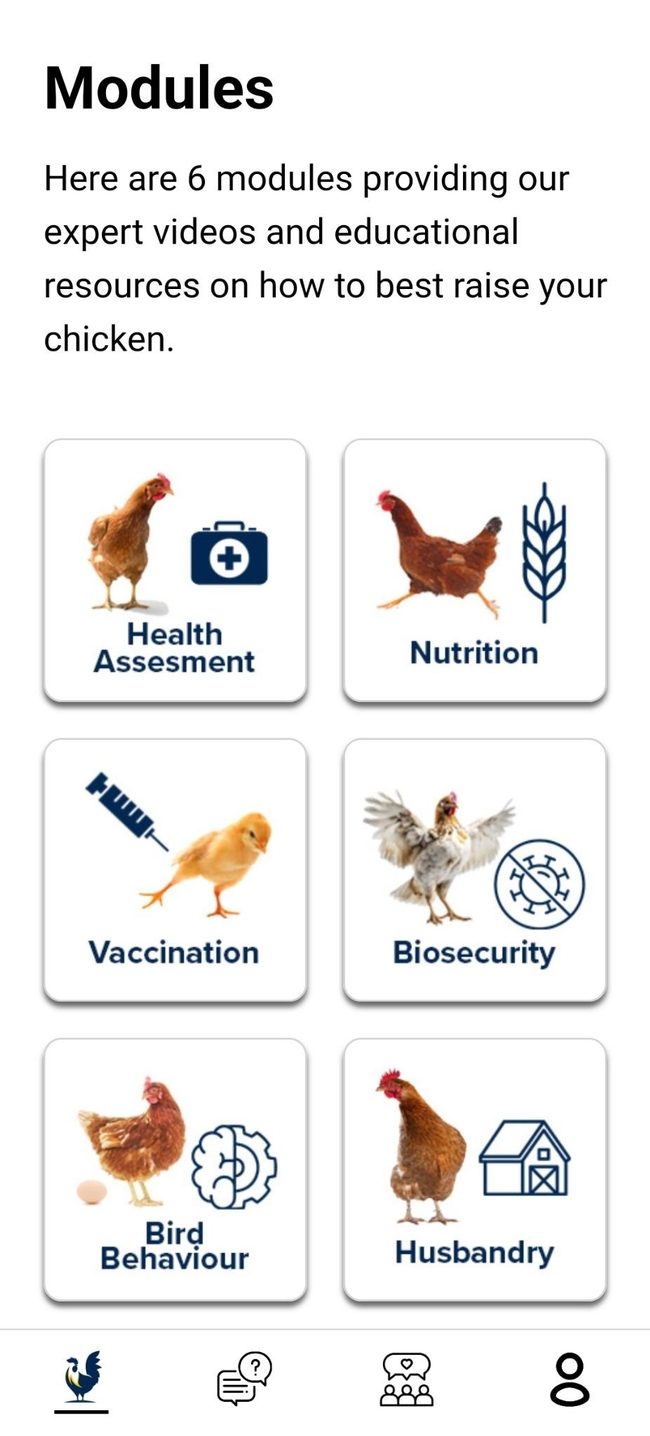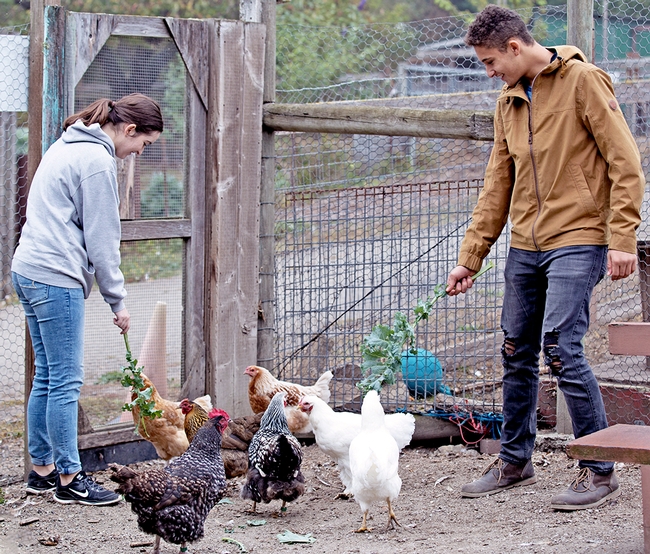Posts Tagged: chickens
Lawn-pocalypse! Surviving Drought
Ah, summer! The season of sunburns, pool parties, and… lawn droughts. If your once lush, green carpet now looks like a crunchy brown doormat, you're not alone. Let's dive into why your yard is staging a dramatic death scene and what you can do to...

Bermuda grass and weeds overtaking drought stressed turf grass.
Tips on care of backyard chickens, sheep, goats compiled on new website
UC Cooperative Extension expertise available in English and Spanish on small-scale livestock production, pasture management, pests and predators, weed management and emergency preparedness
A team of University of California Agriculture and Natural Resources advisors has created a new comprehensive website for small acreage landowners in California and beyond. The Small Acreage Landowners website, at https://ucanr.edu/sites/smacreage, is designed to be a one-stop shop for backyard livestock producers, youth raising livestock, and other small acreage landowners. Information on livestock husbandry, pasture management, pests and predators, weed management and emergency preparedness is in English and Spanish on the website.
“We've seen an amazing growth in interest in small-scale livestock production throughout California in the last four years,” said project leader Julie Finzel, UC Cooperative Extension livestock and natural resources advisor for Kern, Tulare and Kings Counties. “Folks in our communities are hungry for knowledge about how to care for their land and their animals – from urban chickens to backyard goats and sheep.”
The website includes specific information for most common livestock species, as well as links to sites with more in-depth information about specific topics. Other pages include information on protecting livestock and property from pests and predators, controlling common weeds and protecting water quality.
The site also provides links to a variety of other UC ANR resources, including wildfire information from the Fire Network, and videos and webinars from the UC ANR Managing Land & Livestock on Small Acreage Webinar Series.
“We're excited this new website will make science-based information available to a wider audience,” said Finzel. “Most of our educational programming has focused on commercial livestock production.”
In addition to Finzel, a team of UC Cooperative Extension livestock advisors contributed to the project, including Theresa Becchetti (Stanislaus and San Joaquin counties), Brooke Latack (Imperial, Riverside and San Bernadino counties) Dan Macon (Placer, Nevada, Sutter and Yuba counties), Devii Rao (San Benito, Santa Cruz and Monterey counties), Rebecca Ozeran, former UC Cooperative Extension livestock advisor for Fresno and Madera counties and Flavie Audoin, former UCCE advisor for the Central Sierra now rangeland management extension specialist at University of Arizona. UC ANR technician Sequoia Williams in Placer County compiled information and designed the webpages.
The Small Acreage Landowners website was created in part with funds from a USDA-NIFA Renewable Resources Extension Act grant.
Updated March 6, 2024, to add Flavie Audoin as a contributor to the website.
Chicken community ‘coop-eration’ needed to test UC poultry health app
If you raise backyard chickens or breed game fowl, UC Cooperative Extension has an app for you. The new mobile app offers information for raising healthy chickens.
To test the usefulness of the UC Community Chicken app to people raising chickens, the Poultry Lab at the UC Davis School of Veterinary Medicine will pay poultry owners to participate in a two-week study with a follow-up survey three months later.
“Our study focuses on the development and evaluation of a new mobile app for backyard chicken owners and game fowl breeders,” said Maurice Pitesky, UC Davis School of Veterinary Medicine associate professor of Cooperative Extension. “The goal is to examine the app's effectiveness as a communication tool within the poultry community.”
To be eligible, participants must be backyard chicken owners who are 13 years or older or game fowl breeders over 18 years of age. They will need to have Apple or Android phones or tablets to access the app.
What's in the app?
The UC Community Chicken app contains six educational modules with short videos that cover health assessment, nutrition, vaccination, biosecurity, bird behavior and husbandry. It also features chat and feedback buttons so participants can communicate with the UC experts and other poultry owners.
“We value the thoughts and experiences of people who are raising poultry,” said Myrna Cadena, Ph.D. student in Pitesky's lab. “Their input will be valuable in shaping the way we extend information about poultry health.”
Study timeline
For two weeks, participants will explore the educational resources and other features and complete the surveys. Three months later, the researchers will follow up with a survey to assess the chicken owners' progress.
Participants who complete the entire study and follow-up survey will receive a $25 Amazon gift card via email. Those who do not finish the entire study will be compensated based on their level of participation. The study will be limited to 220 participants.
To register for the study, go to https://bit.ly/UCchickenapp. Once the study is ready, participants will be notified via email. The UC Community Chicken app will be available to the public after the study is complete. For more information about the study, contact Maurice Pitesky at drcluck@ucdavis.edu.
Bird owners urged to take precautions for avian flu
The highly contagious avian flu is being spread primarily by migratory birds, putting game birds, and backyard and commercial poultry at risk.
“Poultry owners should take precautions to prevent their birds from contacting waterfowl or the habitat that waterfowl frequent because this strain of avian influenza is highly contagious,” said Maurice Pitesky, UC Davis School of Veterinary Medicine associate professor of Cooperative Extension.
Infected waterfowl shed the highly pathogenic avian influenza virus in their feces and respiratory secretions, where the virus can remain viable for months in the environment.
“If you can't confine your birds in a coop, focus on good sanitation and reducing contact with waterfowl and their habitat such as agricultural fields and ponds,” he said.
Pitesky urges commercial and backyard chicken owners to monitor their birds for the following symptoms:
- Reduced egg production
- Trouble breathing
- Clear, runny discharge from nose, mouth and eyes
- Lethargy or lack of energy
- Loss of appetite
- Drinking less
- Swollen eyes, head, wattles or combs
- Discolored or bruised comb, wattles or legs
- Sudden death
To prevent exposure to potentially infected waterfowl, Pitesky suggests reassessing and redoubling biosecurity efforts to prevent contact between wild animals and domestic poultry.
Specifically, he recommends keeping birds away from ponds and other open water where they may contact waterfowl, which are the primary reservoir of the disease. To prevent cross-contamination, use clothing and boots that stay on your property and avoid sharing equipment with other bird owners.
A local veterinarian or UC Cooperative Extension farm advisor may have more suggestions to reduce risk.
For more information about protecting birds from avian influenza, visit https://ucanr.edu/sites/poultry/files/225352.pdf.
Unusual or suspicious sick or dead domestic birds should be reported to the California Department of Food and Agriculture Sick Bird Hotline at (866) 922-2473.
Suspicious wild bird deaths can be reported to California Department of Fish and Wildlife (CDFW) at https://wildlife.ca.gov/Conservation/Laboratories/Wildlife-Health/Monitoring/Mortality-Report.
Climate-Change Resources
University of California UC ANR Green Blog (Climate Change and Other Topics) https://ucanr.edu/blogs/Green/index.cfm?tagname=climate%20change (full index)
Examples:
- Save Trees First: Tips to Keep Them Alive Under Drought https://ucanr.edu/b/~CdD
- Landscaping with Fire Exposure in Mind: https://ucanr.edu/b/~G4D
- Cities in California Inland Areas Must Make Street Tree Changes to adapt to Future Climate https://ucanr.edu/b/~oF7
Drought, Climate Change and California Water Management Ted Grantham, UC Cooperative Extension specialist (23 minutes) https://youtu.be/dlimj75Wn9Q
Climate Variability and Change: Trends and Impacts on CA Agriculture Tapan Pathak, UC Cooperative Extension specialist (24 minutes) https://youtu.be/bIHI0yqqQJc
California Institute for Water Resources (links to blogs, talks, podcasts, water experts, etc.) https://ciwr.ucanr.edu/California_Drought_Expertise/
UC ANR Wildfire Resources (publications, videos, etc.) https://ucanr.edu/News/For_the_media/Press_kits/Wildfire/ (main website)
-UC ANR Fire Resources and Information https://ucanr.edu/sites/fire/ (main website)
-Preparing Home Landscaping https://ucanr.edu/sites/fire/Prepare/Landscaping/
UC ANR Free Publications https://anrcatalog.ucanr.edu/ (main website)
- Benefits of Plants to Humans and Urban Ecosystems: https://anrcatalog.ucanr.edu/pdf/8726.pdf
-Keeping Plants Alive Under Drought and Water Restrictions (English version) https://anrcatalog.ucanr.edu/pdf/8553.pdf
(Spanish version) https://anrcatalog.ucanr.edu/pdf/8628.pdf
- Use of Graywater in Urban Landscapes https://anrcatalog.ucanr.edu/pdf/8536.pdf
- Sustainable Landscaping in California https://anrcatalog.ucanr.edu/pdf/8504.pdf
Other (Non-UC) Climate Change Resources
Urban Forests and Climate Change. Urban forests play an important role in climate change mitigation and adaptation. Active stewardship of a community's forestry assets can strengthen local resilience to climate change while creating more sustainable and desirable places to live. https://www.fs.usda.gov/ccrc/topics/urban-forests
Examining the Viability of Planting Trees to Mitigate Climate Change (plausible at the forest level) https://climate.nasa.gov/news/2927/examining-the-viability-of-planting-trees-to-help-mitigate-climate-change/
Reports and other information resources coordinated under the auspices of the United Nations and produced through the collaboration of thousands of international scientists to provide a clear and up to date view of the current state of scientific knowledge relevant to climate change. United Nations Climate Action
Scientific reports, programs, action movements and events related to climate change. National Center for Atmospheric Research (National Science Foundation)
Find useful reports, program information and other documents resulting from federally funded research and development into the behavior of the atmosphere and related physical, biological and social systems. Search and find climate data from prehistory through to an hour ago in the world's largest climate data archive. (Formerly the "Climatic Data Center") National Centers for Environmental Information (NOAA)
Think tank providing information, analysis, policy and solution development for addressing climate change and energy issues (formerly known as the: "Pew Center on Global Climate Change"). Center for Climate & Energy Solutions (C2ES)
Mapping Resilience: A Blueprint for Thriving in the Face of Climate Disaster. The Climate Adaptation Knowledge Exchange (CAKE) was launched in July 2010 and is managed by EcoAdapt, a non-profit with a singular mission: to create a robust future in the face of climate change by bringing together diverse players to reshape planning and management in response to rapid climate change. https://www.cakex.org/documents/mapping-resilience-blueprint-thriving-face-climate-disaster
Cal-Adapt provides a way to explore peer-reviewed data that portrays how climate change might affect California at the state and local level. We make this data available through downloads, visualizations, and the Cal-Adapt API for your research, outreach, and adaptation planning needs. Cal-Adapt is a collaboration between state agency funding programs, university and private sector researchers https://cal-adapt.org/
Find reports, maps, data and other resources produced through a confederation of the research arms of 13 Federal departments and agencies that carry out research and develop and maintain capabilities that support the Nation's response to global change. Global Change (U.S. Global Change Research Program)
The Pacific Institute is a global water think tank that combines science-based thought leadership with active outreach to influence local, national, and international efforts to develop sustainable water policies. https://pacinst.org/our-approach/
Making equity real in climate adaptation and community resilience policies and programs: a guidebook. https://greenlining.org/publications/2019/making-equity-real-in-climate-adaption-and-community-resilience-policies-and-programs-a-guidebook/
Quarterly CA Climate Updates and CA Drought Monitor Maps (updated each Thursday) https://www.drought.gov/documents/quarterly-climate-impacts-and-outlook-western-region-june-2022

